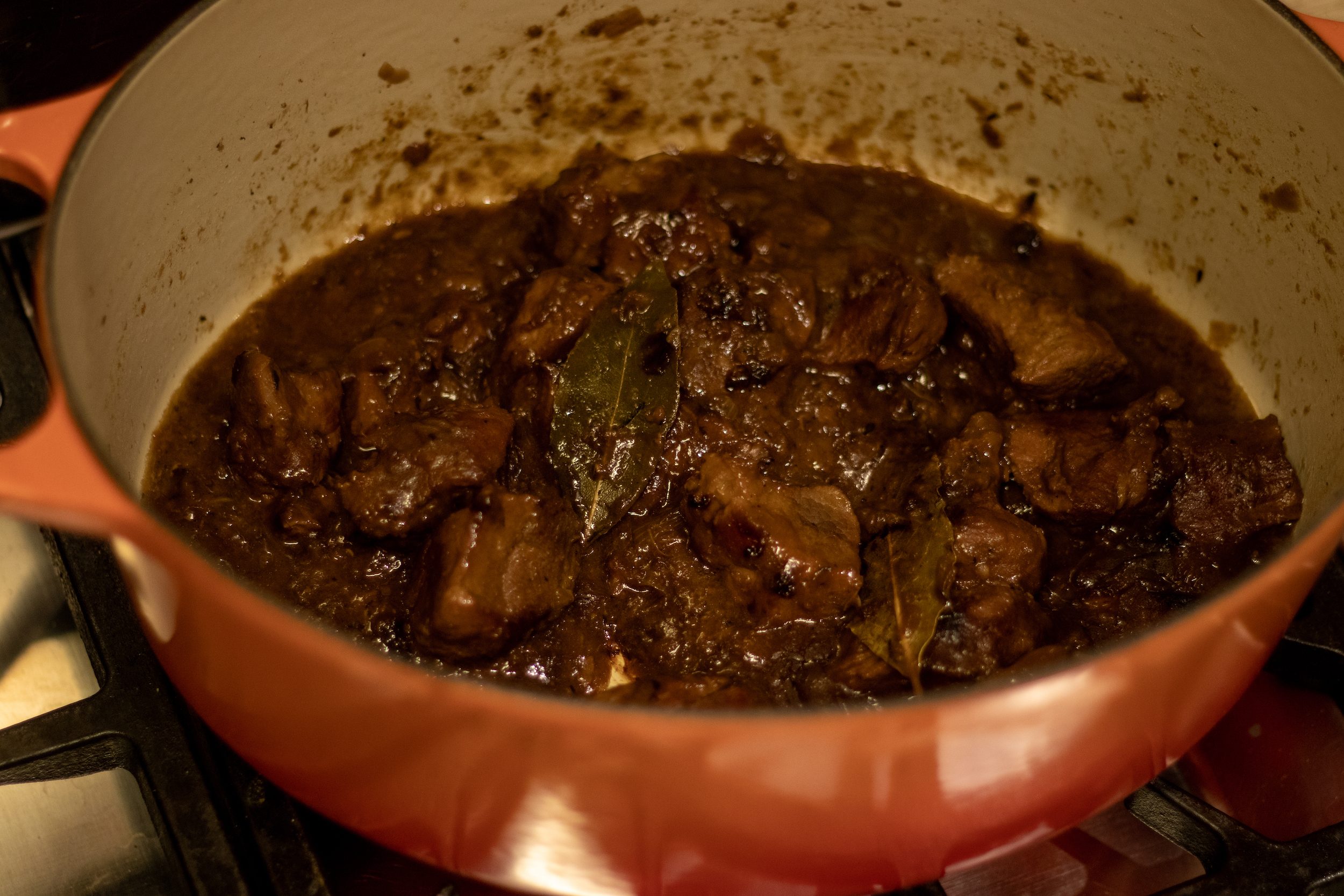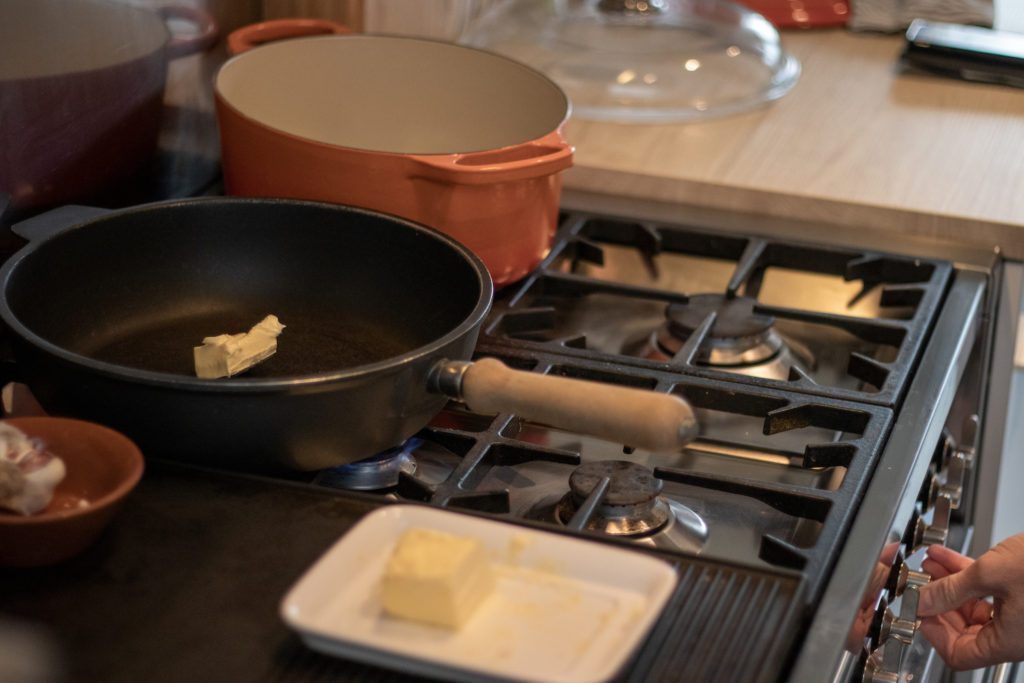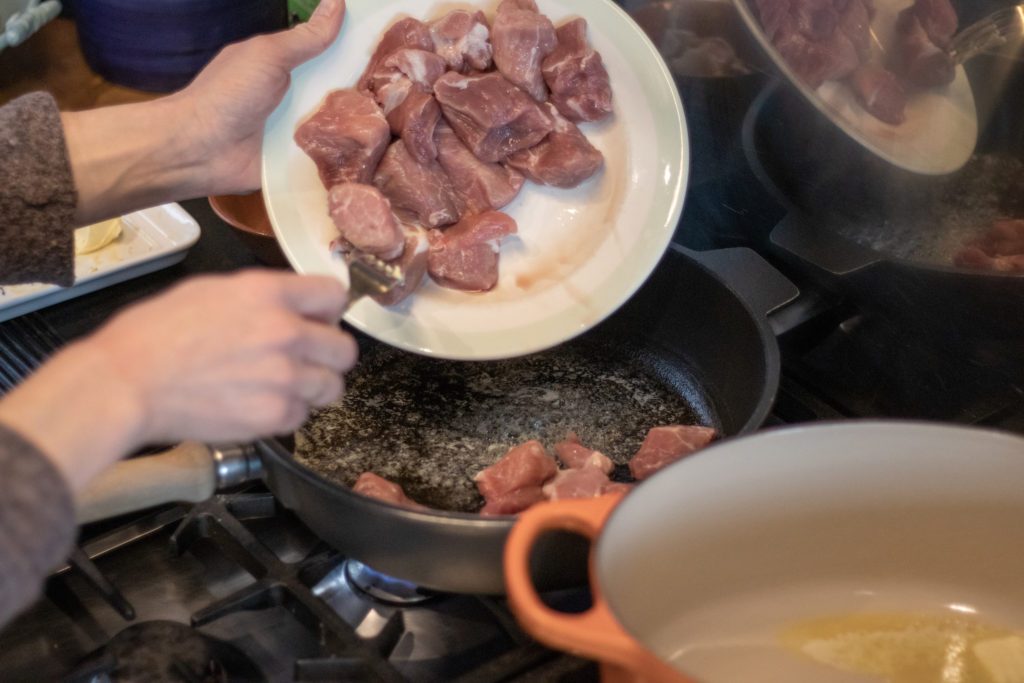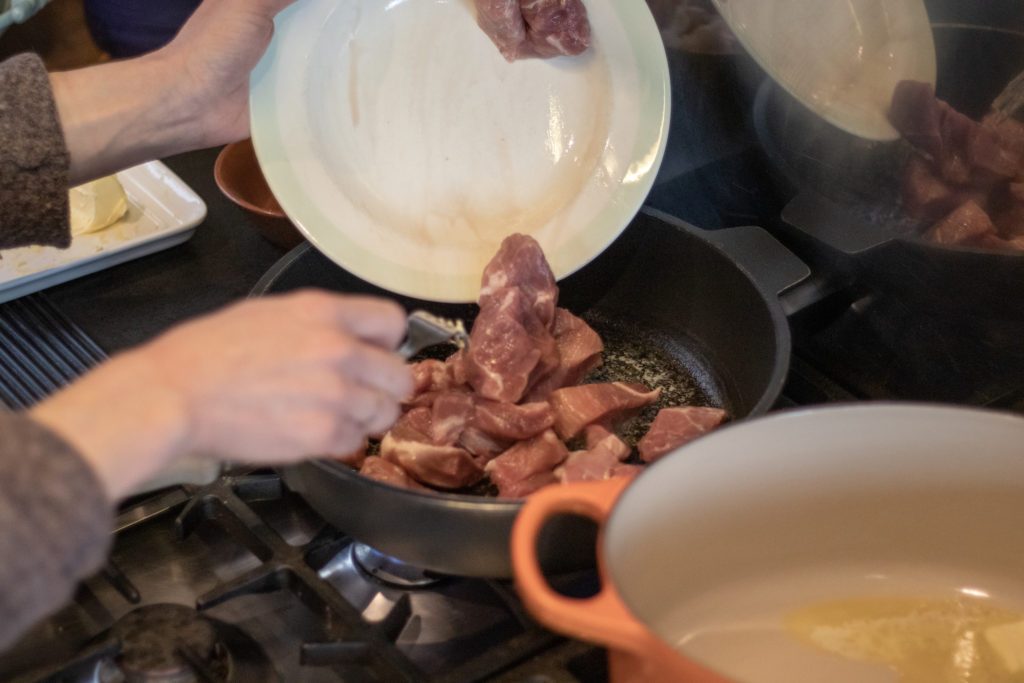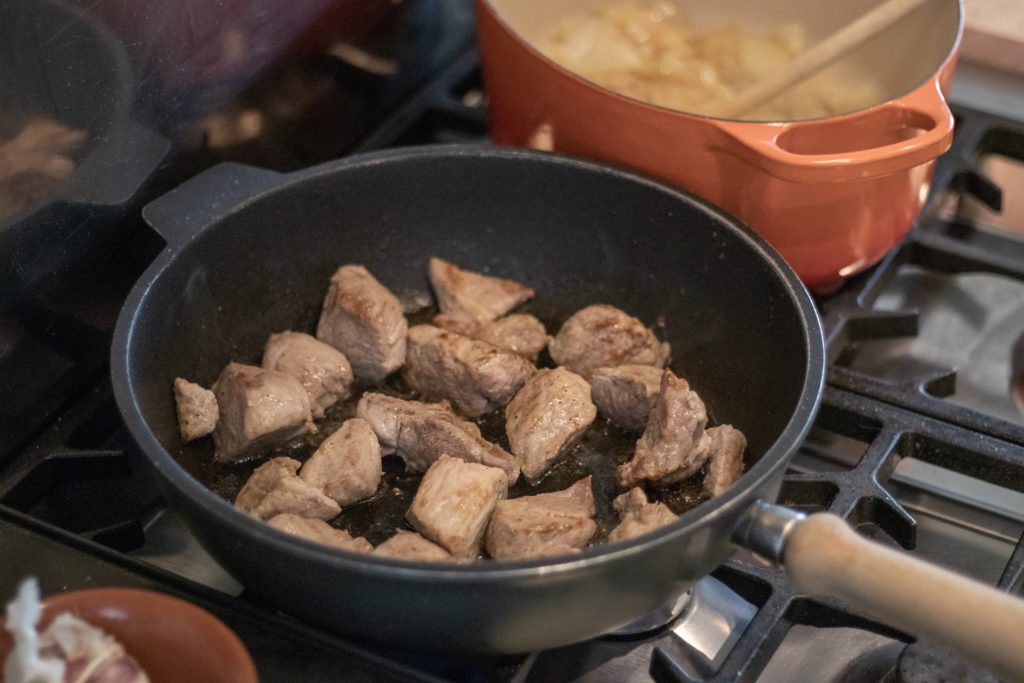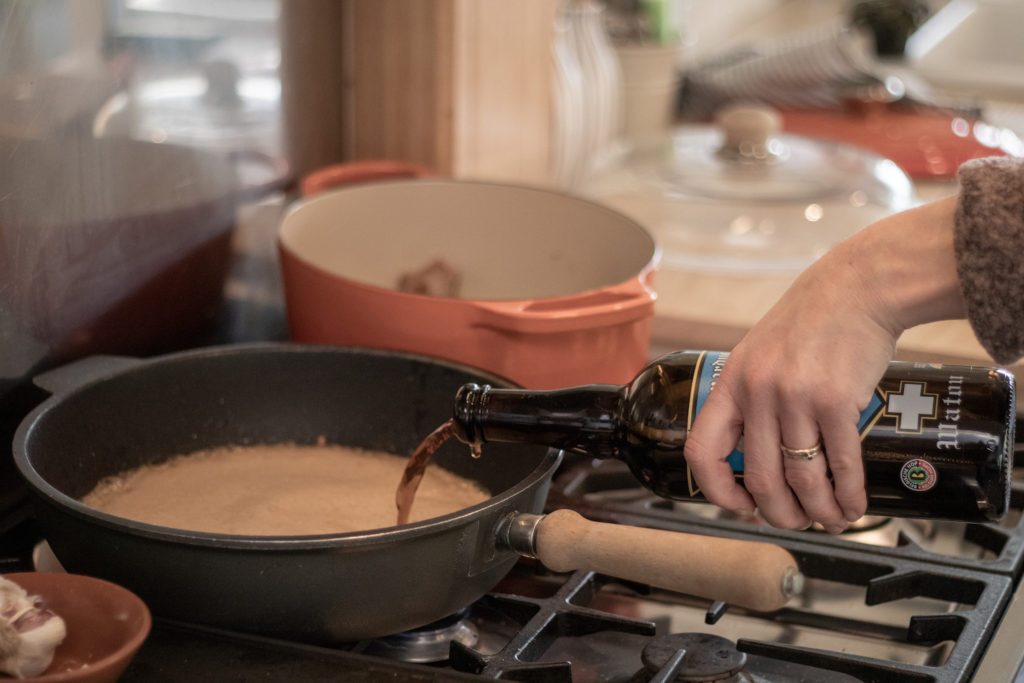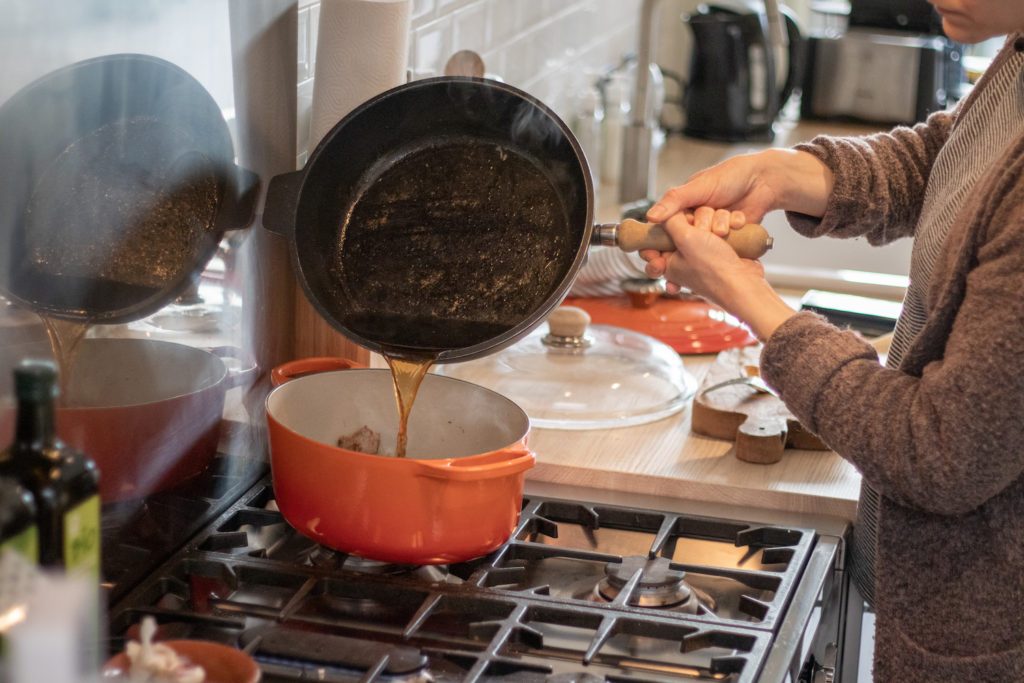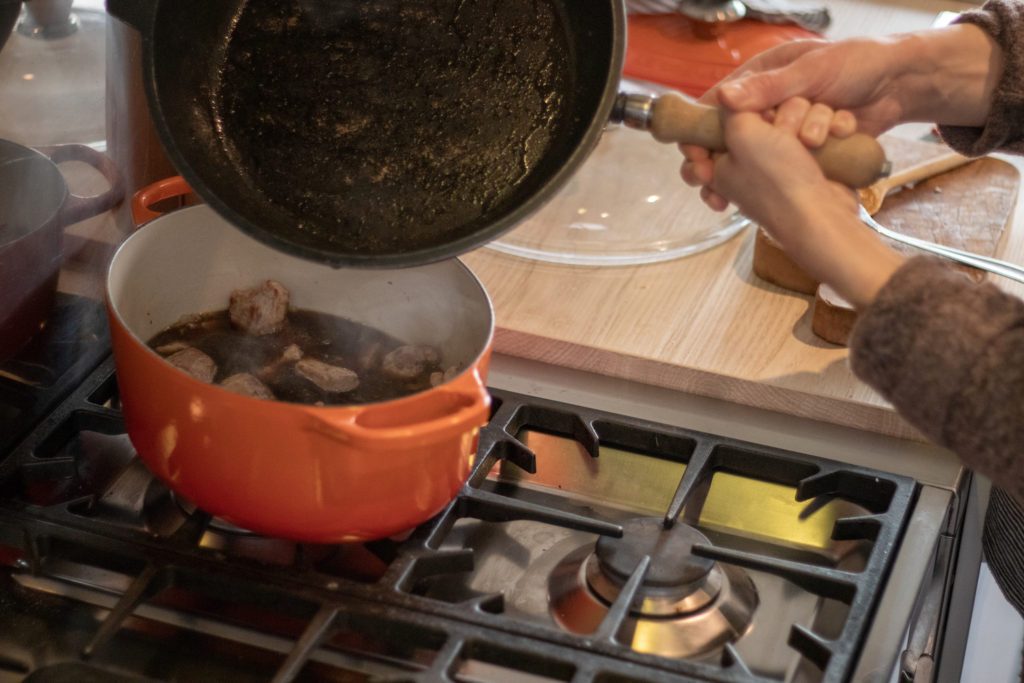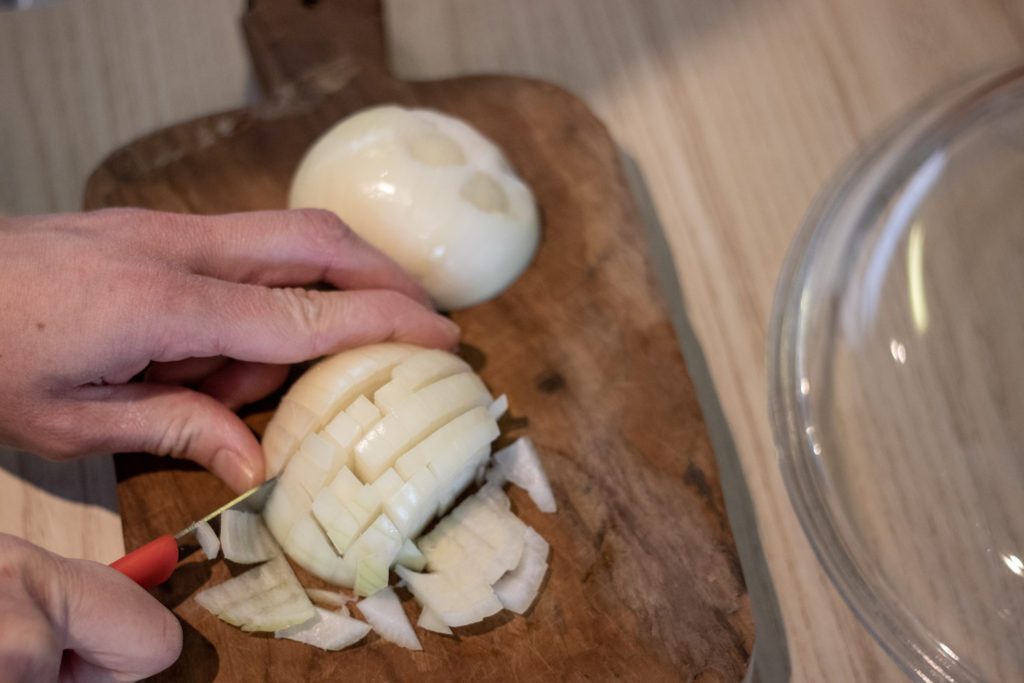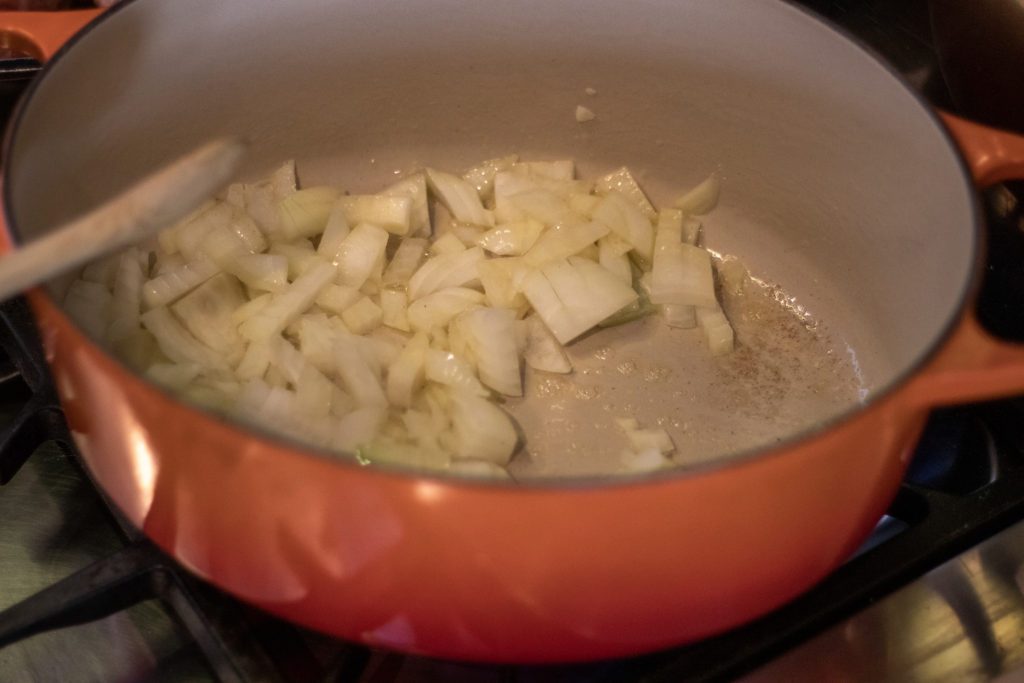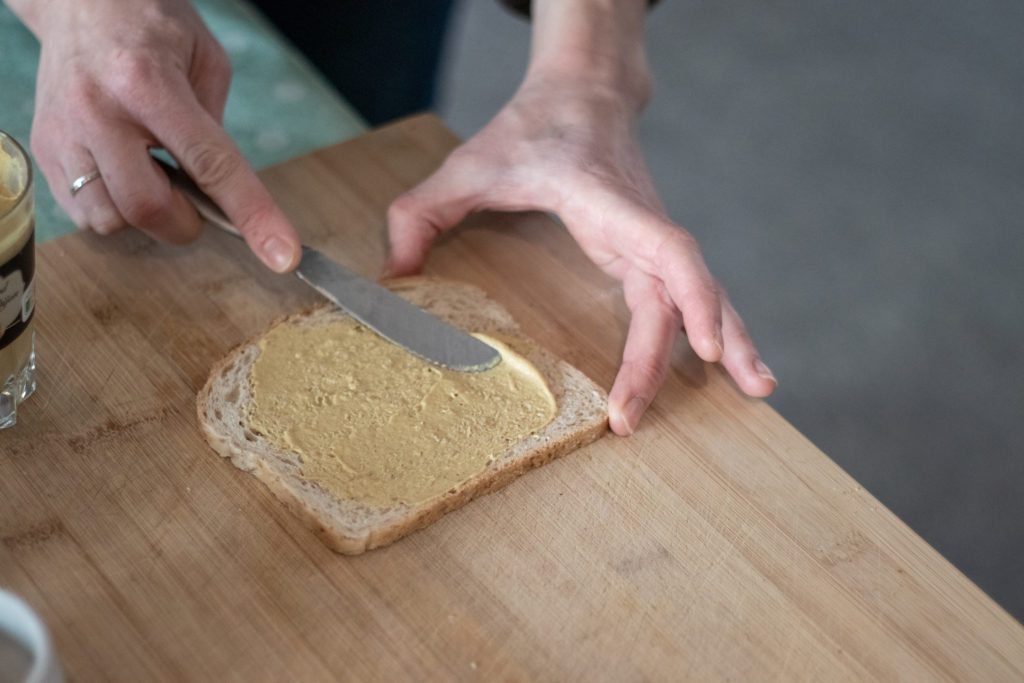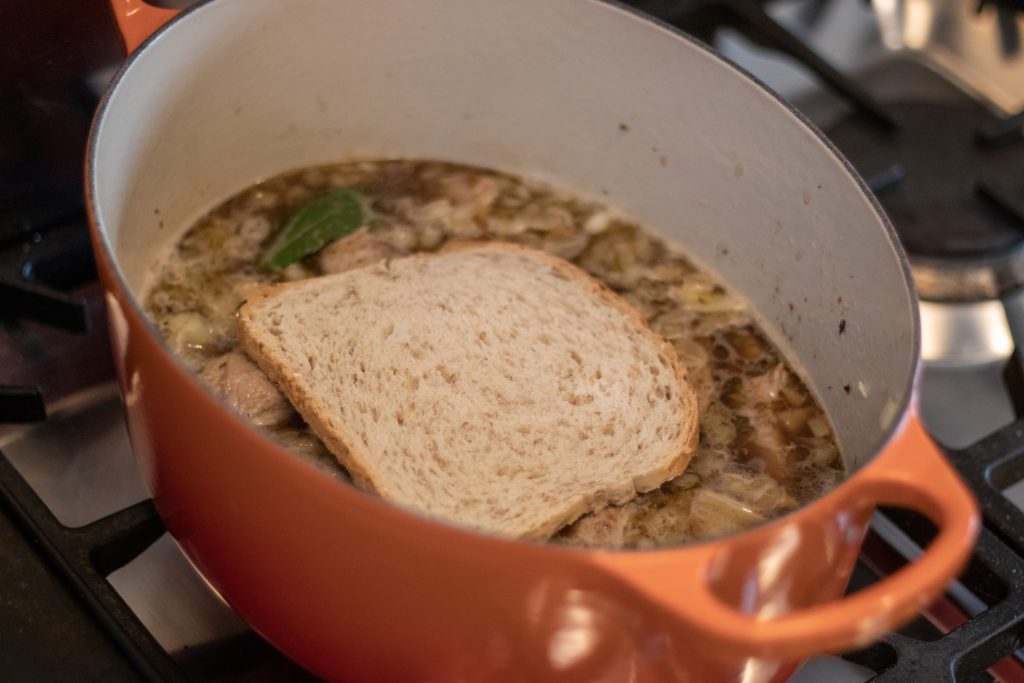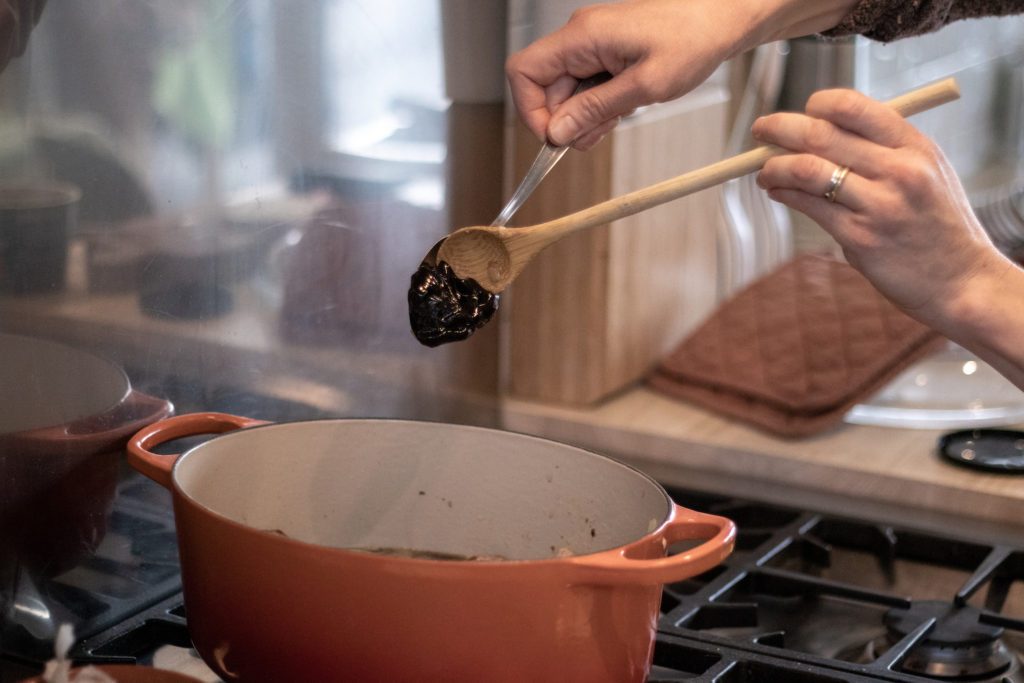Flemish Stew is a traditional meat and onion stew made with Belgian beer. Why is it so popular? How is it cooked? And what are the sacred cows for Belgians when it comes to recipe variations?
Words and photos by Breandán Kearney
Recipe by Elisa Depypere
Edited by Eoghan Walsh
This editorially independent story has been supported by VISITFLANDERS as part of the “Food Group” series. Read more.
Flemish Stew Recipe
Flemish Stew is a rich and savoury traditional meat and onion stew made with Belgian beer.
Ingredients
- One large onion
- 500g pork meat (cut into large chunks)
- Knob of butter
- Pinch of salt
- Pinch of pepper
- 2 bottles x 33cl Belgian Dark Strong Ale (eg. Sint Bernardus Abt 12)
- 1 bay leaf
- 1 sprig of thyme
- 1 tablespoon of Sirop de Liège (apple-pear syrup)
- 1 slice of brown bread
- 1 tablespoon of mustard (Tierenteyn)
Directions
- Peel and roughly chop the onions.
- Heat a large casserole dish (e.g. Le Creuset) and melt a knob of butter in it. Sauté the onions over a medium heat until soft. Do not brown the onions.
- Heat a frying pan over a medium to high heat and melt a knob of butter in it.
- Sear the meat in the frying pan until it has a golden brown crust. Season the meat during searing with some ground pepper and a pinch of salt. It is best to brown a large amount of meat in several turns. When the frying pan is completely full of pieces of meat, it may lose too much moisture and “cook” instead of searing.
- Add the browned meat to the onions. Keep the pan used for searing the meat and pour the brown beer into the leftover juices. While the beer is being brought to a boil, scrape the brown bits from the bottom so they form part of the sauce.
- Once the beer is boiling, pour the entire contents of the pan into the meat stew. (Never pour cold beer directly into the meat.) Add a bay leaf, a sprig of fresh thyme and the sirop de Liège (apple-pear syrup).
- Generously spread a large slice of brown bread with mustard. Place the bread on top of the meat, with the mustard side down.
- Let the stew simmer for one and a half to three hours on a low heat. The lid does not have to be on the pot. The cooking time depends on the quality of the meat. Stir the pot from time to time and check at regular intervals to see if the meat is cooked enough.
- Only once the stew sauce has the desired thickness should you place the lid on the stew.
- Taste, and add some more ground pepper and a pinch of salt to preference.
Flemish Stew—What’s the Deal?
In 2015, to celebrate the 1000th episode of his successful TV cooking show Dagelijkse Kost (“Daily Fare”), popular Leuven-born chef Jeroen Meus held an online public poll to name Belgium’s national dish.
The overwhelming winner was Flemish Stew—in Flemish, Stoofvlees or Stoverij (stoven is the verb to stew). In French-speaking Wallonia, it’s known as Carbonnades Flamandes. Distant runners-up included witloof (Belgian endive) with ham and a cheese sauce, steak and fries with a Béarnaise sauce, and vol-au-vent (puff pastry with chicken filling).
In the days after Meus announced the winner during his show on Eén (a public Flemish TV station, the UK equivalent of which would be BBC One), Belgian supermarket Delhaize sold 10,000 kilograms of stewing beef when on a normal weekend they might sell 4,000 kilograms. Meus appeared a few days later at the start of the famous cycling race Kuurne-Brussels-Kuurne to dish out his Flemish Stew to spectators. Here together were the Flemish trinity of cycling, meat, and beer.
“Flemish Stew is comfort food,” says chef and culinary expert Pieter Declercq, formerly of national TV food channel VTM Koken and now owner of Food Studio Coeur De Boef. “Every household has its own recipe. You make it in one big pot and you put it on the table. It’s inexpensive and it’s easy. And you make it with beer, which is probably a reason why it’s so popular.”
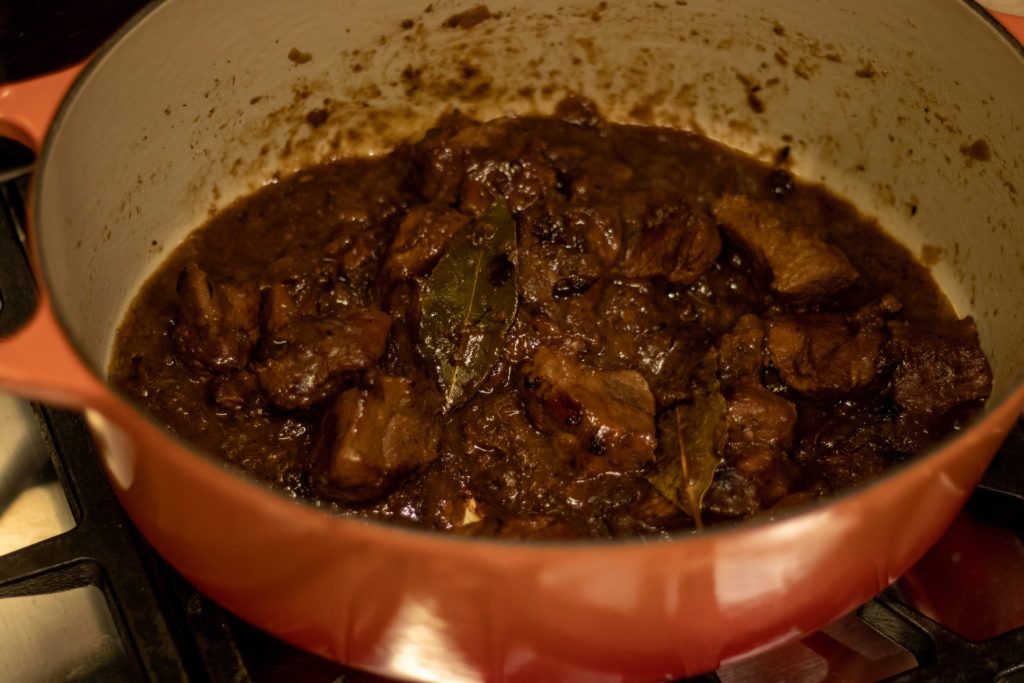
Global Comfort Food
Declercq is right: stews are the ultimate comfort food: meat and vegetables slow-cooked at a low temperature in liquid and served in the resulting sauce. Stews are high in calories and carbohydrates and uncomplicated to prepare, often providing nostalgic or sentimental value given their connection to family life.
Stews have been around since ancient man learned to cook over fire. Cultures all over the world have their own stews, adapted to their particular culinary context. Amazonian tribes used the shells of turtles to slowly cook the animal’s entrails in hot water. Irish stew puts lamb and mutton centre-stage. The French stew beef in burgundy wine to create Beef Bourguignon. Russians use sour cream and call it Stroganoff. For Hungary, read paprika and Goulash. And to create their Flemish Stew, the Belgians use the culinary product for which they are most famous: beer.
The Flemish Stew—Stoverij—is not to be confused with other stew-like dishes that have their origins in Flanders. The Waterzooi, for example, is a stew most associated with the city of Ghent (the Gentse Waterzooi) which is often made of fish or chicken. Vlaamse Hutsepot (hutsen is to shake up the pot during slow cooking) is a stew made from oxtail, shoulder of mutton, salted bacon, and vegetables such as carrots, parsnips, onions, leeks and celery, all of which are served whole.
These other stews are delicious, and in their particular corners of Flanders enjoy exhibitions of real pride, but neither have the cultural cachet nor national prominence of Stoverij and its beer sauce. Indeed few of these alternatives have overcome the socio-cultural and linguistic divides that separate Flanders from Wallonia in the way Stoverij has, making it perhaps one of the few shared national icons of Belgian identity on the same level of fries, the national football team, and needless bureaucracy.
Traditional and Contemporary Flemish Stew
There are hundreds of Flemish Stew recipes to choose from. One of the most popular traditional recipes come from Ons Kookboek (“Our Cookbook”), a 1927 tome produced by the Katholiek Vormingswerk Landelijke Vrouwen (“Catholic Formation of Rural Women”) and the updated editions of which are near-ubiquitous in Flemish kitchens. Another totemic recipe that influenced generations of stew cooks is in Koken voor elke dag (“Cooking for Every Day”) first published in 2000 and edited by the Kristelijke Arbeiders Vrouwengilde (“Christian Workers Women’s Guild”).
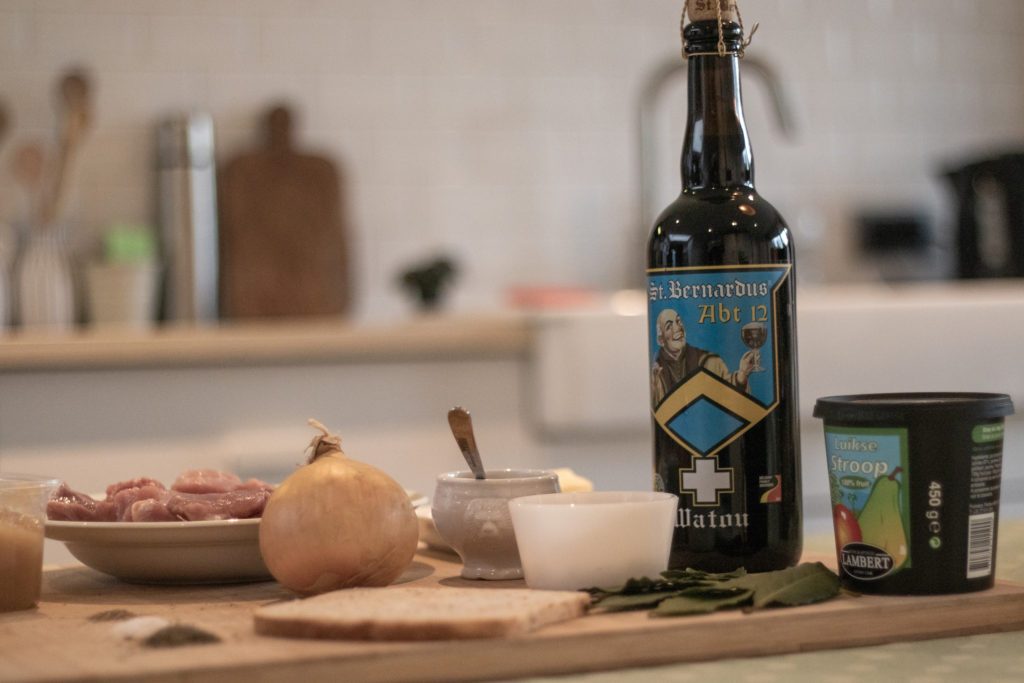
In 2006, the Academy for Regional Gastronomy published “Flemish Stew: The most common Flemish dish nationally and internationally” (Vlaamse stoofkarbonaden: Het nationaal en internationaal meest voorkomend Vlaams gerecht), a 68-page book written by authors Crauwels, Schouterden, Steps, and Van Caenegem about the history of ingredients, and the preparation methods of the past and present.
Anecdotal evidence suggests that the most popular Belgian recipe for Flemish Stew today is the Jeroen Moes recipe on his Dagelijkse Kost website and in his cookbook of the same name.
Each of these recipes suggest a variety of ingredients and cooking methods, a diversity which Belgians have developed regionally depending on what’s available to them, and which hints at how the Belgian kitchen has evolved over the years. While some of these variations are uncontroversial, many are hotly-contested, taken as an affront to the Belgian character of the dish.
The Meat of the Matter
The most common meat used in Flemish Stew is beef. It’s proposed by Meus, as well as in international recipes like on the BBC’s Goodfood website.
However, in parts of Flanders there are fierce advocates for pork, very much depending on the region—for example, the several butchers in West Flanders visited to source the meat for the recipe above all suggested pork. This makes sense, as Belgium produces a lot more pork than beef—1.07 million tonnes of the former is produced annually in Belgium versus 216,000 tonnes of the latter.
Interestingly, many of the older recipes do not actually specify which meat should be used. Ons Koekboek, for example, notes only that the meat should be “of 2nd quality, so rump, shoulder, or brisket” (“van 2de kwaliteit, dus bil-, schouder-, of borststuk”). This reflects the functionality of the dish as an affordable family meal for people of all backgrounds.
Usually, the type of lean, unsalted meat which has traditionally been used in Flemish Stew is tough but very nutritious, and requires a long, slow cooking time to tenderise. As Flemish Stew has evolved from its humble beginnings, however, the quality of meat has moved on from “2nd quality” to something more tender, and the resultant cooking times can sometimes be shortened.
The Beer Sauce Conundrum
If meat is essential to any good stew, then the addition of beer is what makes a Flemish Stew a Flemish Stew. The sauce of Flemish Stew is made entirely from beer and the juices yielded from searing the meat, and there are three types of beer commonly used in Flemish Stew.
The first is the Belgian Dark Strong Ale, a brown-coloured, complex, high alcohol, top fermented beer with a delicious blend of malt richness, red fruit flavours, and spicy notes. This style is most associated with Belgium’s Trappist Abbeys and classic examples include Rochefort 10, Chimay Bleue, and Westmalle Dubbel. Our recipe uses Sint Bernardus Abt 12 and the resulting sauce is rich, sweet, savoury, and intense.
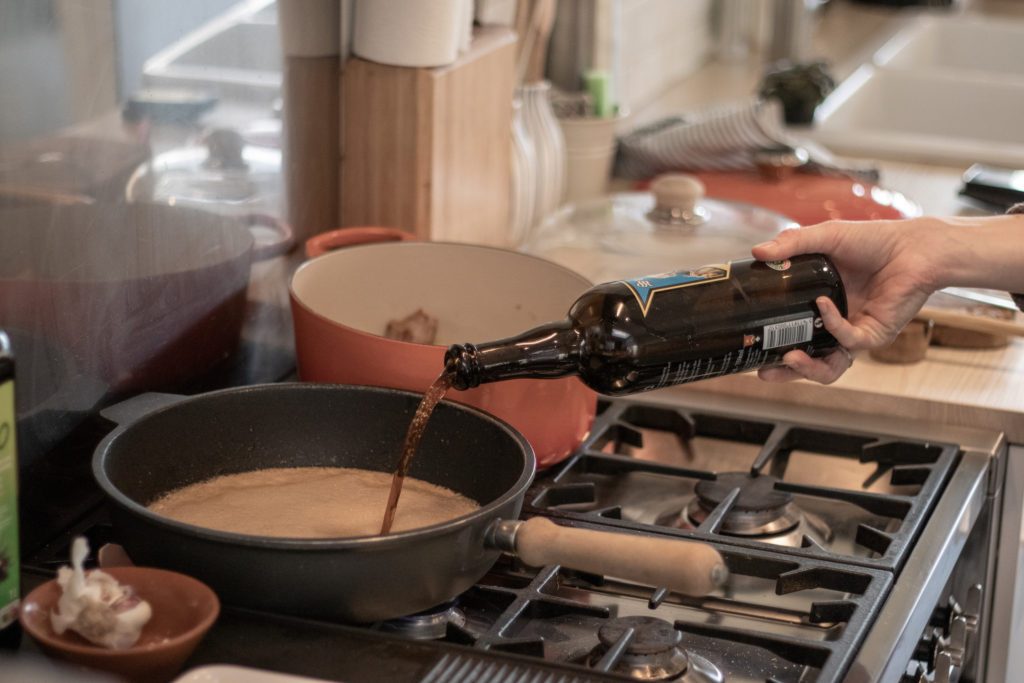
The second option is Flemish Red-Brown, a sweet and sour beer of mixed fermentation which presents with a red wine-like character, interesting malt flavours, and fruit complexity. It’s the beer most commonly used in Flemish Stew from South-west Flanders, where people are rightly proud of their regional speciality.
The most famous of these sweet-sour beers is Rodenbach, and in particular the Rodenbach Classic. Other potential alternatives include Petrus Oud Bruin, Vanderghinste Oud Bruin, Duchesse de Bourgogne, and Liefmans Oud Bruin. Sometimes, vinegar is included in recipes which do not use this beer style to equip the stew with an acidic touch.
It’s generally accepted that while a subtle acidic profile (in combination with sweetness) can be effective in cutting through the fattiness of the meat, too much acidity will make the dish unpalatable. For this reason, more acidic beers like Lambic and Geuze are almost never used in Flemish Stew.
The third possibility is Table Beer: sweet, malty, low-bitterness and low-alcohol ales which in the 1920s were commonly enjoyed by Belgian children and their parents at the dinner table in place of sugary soft drinks or unfiltered water. While restaurants and family meals prepared for special occasions usually opt for either of the first two options, Table Beer is the cheapest choice and tends to be used by larger catering businesses, hospitals, nursing homes, and educational institutions—all of which produce industrial quantities of Flemish Stew, meaning Table Beer may be the style of beer most frequently used to make Flemish Stew in Belgium.
Table Beer delivers a pleasantly sweet sauce, but one with much less flavour intensity than options one and two above. The most common brands used are those most accessible in Belgium: Bruin Leroy in West Flanders, and Piedbouef Bruin Foncée in the rest of the country.
Other dark beers like Stouts and Porters are hardly ever used because they would impart an otherwise undesirable malt bitterness, but also because they do not have the widespread cultural grip in Belgium of the other styles.
One commonly agreed guideline across recipes is the sauce be made with only one beer, and not a mix of beers. Recipe writers also suggest the beer served alongside the meal should be the same beer used to make it.
Additions of the Garden Variety
Reporting suggests that you need only one vegetable to make Flemish Stew: the mighty onion. Generally, yellow onions are used for their sharp, almost spicy flavours, and for the fact that they can become sweeter and browner when cooked in butter. Sweet onions and white onions are good alternatives, and red onions are sometimes chosen for their milder, sweeter character.
Carrots, a popular stewing vegetable elsewhere, are widely considered by most recipes as being out of place in Flemish Stew because of their sweetness. Some argue carrots push a stew in the direction of the Hutsepot. Garlic is rarely mentioned. Mushrooms even less so. And you can forget about bell peppers, courgettes, and cucumber.
There is a more forgiving difference of opinion when it comes to using spices and herbs, and as a result, more opportunity for personal flair. The most commonly used herbs are whole bay leaves, which give a distinctive flavour and fragrance not unlike that of thyme. Thyme itself is also commonly added, but in small quantities so it is mildly floral rather than outright minty. Salt and pepper are accepted for seasoning.
Parsley is regularly mentioned for its mild, herbal character, as are chives to compliment the onion. Some recipes include rosemary, although usually in small proportions due to the potential potency of its hot, smoky, almost woody flavours. A more controversial addition is cloves, which can complement the stew’s sweeter and acidic notes, but whose spiciness can very easily become dominant and overbearing. Less discussed, but still found in more traditional versions of Flemish Stew, is the addition of juniper berries, which can impart resinous, green-like, and background citrus flavours.
Thickeners and Intensifiers
Given enough time, it’s likely that the beer sauce will thicken to the desired viscosity as it cooks the meat. Pieter Declercq of Food Studio Coeur De Boef stews the meat and beer over a low heat in his Le Creuset pan, but sometimes he puts it in the oven for more control, cooking at 140°C for around three hours. “You just [have to] wait,” he says. “Make your fries. Clean your house. Do something else.”
While time is the most important factor in the thickening of the sauce, Belgians have a few techniques to ensure it avoids being watery. One trick is the addition of a slice of brown farmhouse bread, generously covered in a layer of mustard. Adding bread is a given, but unanimity collapses on the question of whether bread should be added with its crusts removed or not.
The bread should not be disturbed once added, instead allowed to disintegrate into the sauce as it cooks, thickening it in the process. It should be placed on the stew mustard-facing down. The mustard type varies from recipe to recipe, but should be “sharp” in its taste, and Meus et al tend to use domestic specialties. Virtually all Flemish Stews in Ghent, for example, would be cooked with locally-made Tierenteyn mustard.
Another commonly used thickener is flour, which thickens without adding much flavour, but which some cooks consider cheating. There is also a cohort of recipe writers who believe in the further addition of peperkoek, a sweet rye-based cake-bread analogous to gingerbread which can be found in many Belgian homes and is spiced with cloves, cinnamon, ginger, and nutmeg.
Sweeteners and Flavours
In Flemish Stew, the stewed meat gives juicy, savoury flavours which are balanced by the sweetness of the beer and mustard acidity. Some recipes, however, ramp up the sweetness with ingredients commonly found in Belgian kitchens.
The one most often used is Liège syrup—Sirop de Liège in French; and Luikse siroop in Flemish. It’s a thick, jammy spread made with apples and/or pears (or occasionally apricots). Raisins or plums are also sometimes added for similar reasons. An alternative is natural brown sugar, something Belgians sprinkle on their bread and pancakes at breakfast. There are also some cooks who add small amounts of dark chocolate.
Side Accompaniments
There are two generally accepted ways to serve Flemish Stew. The first is alongside creamy mashed potatoes (purée) and a hot spiced apple sauce (appelmoes).
The second, and favourite—according to the Jeroen Meus “election” results—is with fries and mayonnaise. In this iteration, the Flemish Stew comes with a cold, raw salad of nut lettuce (veldsla) and Belgian endive (witloof), both of which provide a crisp, nutty, bitter riposte to the sweet and savoury flavours of the Flemish Stew.
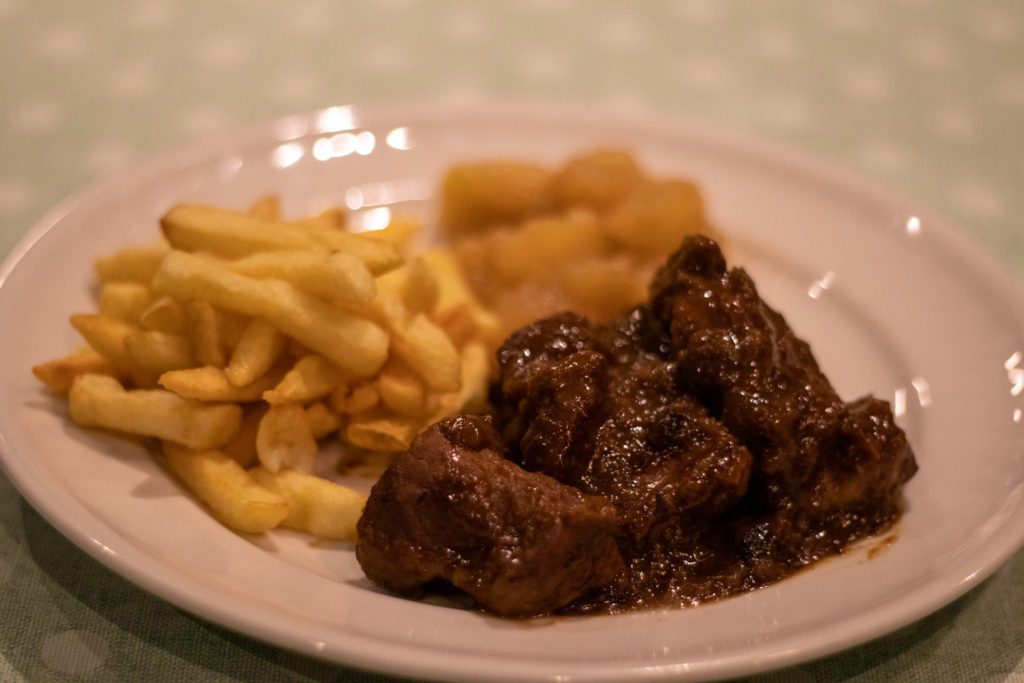
Belgians often have deep-fryers at home and prefer to prepare their own fries instead of cooking oven-ready versions from supermarkets or takeaway fries from the frietkot, but the discussion about the preparation of fries in Belgium is a debate for another day.
Flemish Stew Freedom
Ultimately, how you make your Flemish Stew will be down to personal preference and what you’ve got to hand, but if you’re trying it out for the first time, feel free to experiment with ingredients to discover which variations work best for you.
*


